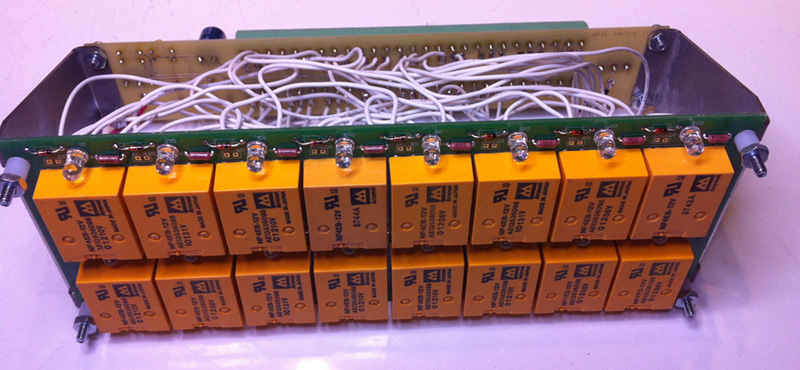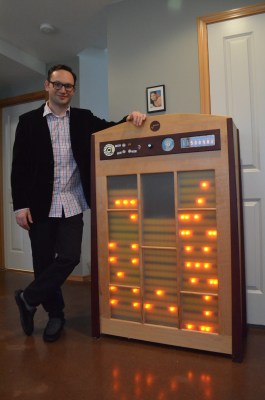After seeing an exhibit of an old relay-based computer as a kid, [Simon] was inspired to build a simple two-relay latching circuit. Since then, he’s been fascinated by how relays can function to do computation. He’s come quite a long way from that first latching circuit, however, and recently finished a huge five-year project which uses electromechanical relays to calculate square roots.
The frame of the square root calculator can hold up to 30 identical relay modules, each of which hold 16 relays on PCBs, for a total of 480 relays. The module-based setup makes repair and maintenance a breeze. Numbers are entered into the computer by a rotary dial from an old phone and stored in the calculator’s relay memory. A nixie tube display completes the bygone era-theme of the device and shows either the current number that’s being entered, or the square root of that number as it’s being calculated.
The real magic of this project is that each relay has an LED which illuminates whenever the relay is energized, which shows the user exactly where all of the bits of the machine are going. [Simon] worked on this project from 2009 and recently completed it in 2014, and it has been featured at the San Mateo Maker Faire and at Microsoft Research in Redmond, WA. We’ve seen smaller versions of this before, but never on this scale and never for one specific operation like square roots.
Video below. Thanks to [Bonsaichop] for the tip!

















That’s awesome
The only thing that would make it better is neon bulbs instead of LEDs :-)
Sweet! Fantastic job.
Impressive, quite a talking piece I should imagine. If I had the money or a barrel load of relays I would love to have one or these.
Blinking lights, clicking relays, I especially like the use of a rotary phone dial. I guess it makes sence as all the timing is aalready done for you.
Expected some fancy sounds, wasn’t disappointed ;)
The clicking of the relays is glorious!
The bell takes this project from “really friggin cool” to “awesome.”
Reminds me of one of Professor Farnsworth’s machines:
Fry: Isn’t that the same machine that makes noses?
Farnsworth: It can do other things. Why shouldn’t it? [He throws the switch.] Of course, even if it is possible to analyse the message, there’s no way of knowing how long it would take. It could take an hour or it could take a hundred million years.
[The machines dings.]
Fry: Is it done?
Farnsworth: Certainly not. Two dings means it’s done. [Two dings.] But not like that. Slightly more rapid.
[Two slightly more rapid dings. Fry gasps. Farnsworth shakes his head.]
“he coulda done that with an AVR”
nah, this is pretty slick.
Very nice :) I love relay stuff.
Wow, very impressive device! I would love to have an opportunity to play with this for an hour or fifteen.
love the clock generator, if i can call it that.
my thoughts as well. wouldn’t have thought of it myself.
Ah– Is that what that is ? I was wondering it’s purpose.
hope he got a good deal on all those relays.
I don’t even care about the square roots, aesthetically this thing is amazing (except for the labels, brass plaques would be much nicer.)
As I have a bit of a headache, if it was mentioned in the boulder’s write ups I may have missed it. I’d be curious as to the power consumption, and if the consumption would vary according to how large or small the number it’s calculating the square root of. I’m sure the sound is fun for awhile becoming maddening as time goes on.
oh boy that brings back teenage memories back :)
useless, powerhungry and REALL REALLY COOL!
A splendid monstrosity. An American intelligence officer brought a relay-based computer to Bletchley Park during the war. It became known as the Dragon for the amount of noise it generated, described as resembling “a monster munching through tin-plate”. After a few weeks of work on the Lorenz cipher it wore its own relays out and was replaced by a machine that used thermionic valves. Eventually, of course, the job was taken over by the Colossus computers.
Excellent! Very entertaining videos – for us geeks! Good Job!!!
As great as his work is, his documentation of it may even be better. Wow! Lots of great stuff. (If he’s reading this: I’d love to read about it on my book reader… perhaps a .pdf of it all?)
would it be possible, to implement fast-invers-squareroot in relais-logic?
hmmm….